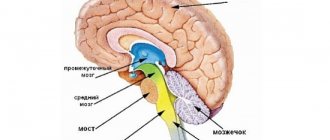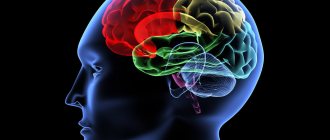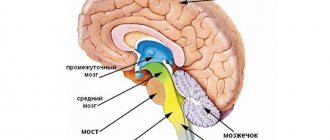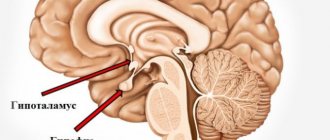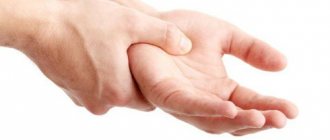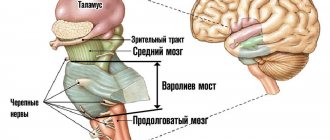Creative hemisphere of the brain
This is not entirely true (not even true at all). To believe that the human brain is divided into two hemispheres and that's it is a gross oversimplification. The brain is a very complex device that is still not fully understood. Indeed, different parts of the brain are activated at different times in our lives. But this is by no means left and right. Scientists have found that the theory that one hemisphere is responsible for logic and rationalism, and the other for creativity and creativity, is a misconception (we wrote more about this here). In reality, everything is much more complicated.
Reasons for the emergence of the myth about functional asymmetry of the cerebral hemispheres
The myth about the functional asymmetry of the cerebral hemispheres appeared for a reason. By and large, the reason for its emergence was the results of studies conducted with people with “split brains”, which were organized by the American neuropsychologist and professor of psychobiology Roger Sperry and a team of his colleagues.
During the research, scientists performed surgeries on people with “split brains,” during which they cut the corpus callosum, which connects the right and left hemispheres of the brain to each other. Through such an operation, which, by the way, was the most extreme option for help, it was possible to relieve patients with severe epilepsy from severe epileptic seizures.
Thanks to laboratory studies of patients with the above-mentioned disease, it was possible to identify their behavioral changes, which indicated that the hemispheres of the brain worked independently of each other. For example, patients, when they felt an object with their right hand, could recognize it and point to its image, but were not able to pronounce the name of this object. And if you install a partition between the eyes of a person with a “split brain”, and then show the left eye (right hemisphere) a photograph of a naked person, he will immediately begin to chuckle. If you ask him what caused his fun, he will answer something like “in the photo I saw my cousin, who always makes great jokes.” The left hemisphere of the brain does not recognize the photo, but given that for the most part it is responsible for processing verbal data, it will independently form some plausible explanation.
Thus, by presenting different stimuli to different hemispheres, separately from each other, scientists were able to find out that they are capable of performing various mental actions with relative success. For example, in a larger number of people, those areas that are responsible for the primary processing of speech data (word formation, grammar, etc.) are located in the left hemisphere, and the right hemisphere takes part mainly in the processes of emotional assessment of phenomena, events and objects .
In addition, the right hemisphere of the brain was very active when a problem given to a person was solved with the help of insight, where awareness of the problem and the search for a solution are carried out spontaneously, one might say, at the level of intuition, which is similar to creative thinking.
But, despite this, the differences between the left and right hemispheres cannot be considered clear and clear to such an extent as to draw any specific conclusions. And in most cases, the conversation is not about the fact that one hemisphere is not capable of performing some function, but about the fact that one hemisphere can perform this function more efficiently and quickly. For example, despite the fact that the main role in speech processing belongs to the left hemisphere, the right hemisphere also takes part in this process, processing intonation, etc.
What is the creative brain
Physiologist and brain researcher Natalya Bekhtereva studied the peculiarities of the brain functioning of creative people back in the 1960s. Among other things, she discovered an error detector, and in connection with this discovery an interesting theory arose.
An error detector is a mechanism in the human brain that reacts to the inconsistency of an event or action with one or another habitual model. The study suggests that “there is a system in the brain that monitors whether you are doing everything correctly, that is, it provides typical solutions to questions.”
For example, when you leave the house and forget your keys and feel “something strange”, this is probably the error detector signaling you about a forgotten item.
In general, this is a good mechanism for humans - it controls us and protects us from misunderstandings. But sometimes he is too controlling - even constraining. That is, it does not allow you to come up with something new and creative.
Bekhtereva suggests that in creative people the error detector is rebuilt in a different way. Instead of offering stereotypical options, he protects against them.
There is also an artificial way to “turn off” this brain mechanism for a while - with the help of alcohol, for example. But this is harmful to health, and it is unlikely that you will be able to engage in creative work in this state for a long time.
Reasons for the popularity of the myth of the left and right hemispheres of the brain
So for what reason is the myth about the functional asymmetry of the cerebral hemispheres so firmly ingrained in people’s consciousness and has become extremely widespread?
One of the reasons is the very simplicity of the interpretation of the work of the brain, which, in addition to everything else, quite easily fits into the framework of common sense. On the one hand, a person has to perform various types of activities that are radically different from each other, but on the other hand, the brain has two similar halves. But why do the brain need them? Most likely, precisely so that they perform various tasks.
Another reason is that the myth we are considering is actively cultivated by popular scientists who are trying to make money from it. Pointing out that modern society is not able to fully appreciate the emotional perception of reality, which is a property of the right hemisphere, adherents of the difference between the hemispheres began to advertise intricate schemes for increasing the activity of the hemisphere, as if responsible for creativity. Numerous seminars, trainings, publications and books by these people promise to those who want to develop to remove from their path of personal development any barriers that are imposed on a person by the ossified system of basic education, which specifically approves of “left-handed” thinking.
Those who strive to develop the right hemisphere have at their disposal a huge number of exercises, which in themselves are completely harmless and even extremely positive, but have nothing to do with this very “development” of the right hemisphere. But the situation is aggravated by the fact that many “specialists” often suggest that people start using some special devices that harmonize and synchronize the work of both hemispheres.
Of course, there is no evidence that a person is able to learn to use a specific hemisphere of the brain separately from the second, or, conversely, learn to use them harmoniously. In fact, if the human psyche works normally, then this work requires the activation of various parts of the hemispheres, and not their synchronization at the first request of the “owner”.
So, remember that during the work of a healthy person’s brain, his hemispheres are in the process of interacting with each other, and the work of these hemispheres itself is harmonized exactly as needed. So you shouldn’t do “it’s not clear what” - it’s better to throw out of your head the idea that the hemispheres of the brain are responsible for different functions, and just start developing your thinking, regardless of what activity you’re doing - logical or creative.
We also recommend reading:
- Storytelling
- Logic vs intuition
- Neurolinguistics: Brief Description and Key Ideas
- “Are you out of your mind?” or 32 exercises for brain development
- How to get more done in 24 hours
- Is there a connection between humor and intelligence?
- Brain development: useful tips and exercises
- “Have you seen it” or Where does the deja vu effect come from?
- Mental arithmetic
- Brain structure
- Meditation practice in the modern world
Key words:1Cognitive science
Three neural networks decide
The results of a more recent study were published in 2018. It was conducted by a group of scientists from Harvard University led by Roger Beaty. More than a hundred subjects took a divergent thinking test (this is a method in which a person solves the same problem in several different ways). During the experiment, the volunteers' brains were scanned using MRI.
As a result, they came to the conclusion that during creative activity, three areas of the brain are activated - the insular lobe (more specifically, the left anterior lobe), the prefrontal cortex and the posterior cingulate cortex.
Simply put, a creative person uses three neural networks at once. One is responsible for imagination, some spontaneous ideas and thoughts. The second network controls these sudden variations and gives them awareness. The third works as a kind of “switch” between the first two.
Right and left hemisphere - creativity and logic
And it is the right, creative hemisphere that is responsible for drawing skills. An important conclusion is that almost anyone can learn to draw if they first learn to suppress the dominant left hemisphere and give free rein to the right.
Why is the left hemisphere so bad at drawing tasks? Because it is accustomed to thinking in clichés that have been ingrained in us since childhood. It is these cliches that prevent you from seeing the true essence of things, from seeing them as they really are, and not as they appear to the left hemisphere. And that is why many people see the same thing in completely different ways.
I read about all this in the wonderful book “Discover the Artist in You” by Betty Edwards, which I recommend for reading both for those who want to learn how to draw and for those who already know how to do it. The book provides simple exercises that will help you develop the skills to activate the right hemisphere of your brain. The meaning of the exercises is simple - you need to perform actions that the right hemisphere is very good at and for which the left hemisphere is absolutely not suitable, and then sooner or later the left hemisphere will give up and give the reins to the right. After such exercises, a person learns to switch to “right-sided” thinking at will.
I give examples of such exercises. The point of the first exercise is to draw a mirror copy of an existing image, while simultaneously “outlining” the existing image with your gaze (the example in the book is “face-vase”, see the illustration for this post).
Another example is drawing an upside down image. Here we take any image we like, turn it over and try to draw, paying attention to individual details, without seeing the picture as a whole. That is, we try to simply copy every line, without thinking about what exactly it is in the drawing. The results are amazing - even people who seem to be completely unable to draw achieve almost perfect results. This is what it means to get rid of cliches.
The third example is the so-called “pure contour drawing”. It consists of methodically drawing chaotic patterns without control over what comes out in the end. In practice, it is recommended to draw a pattern of wrinkles on your own palm without looking at the paper. This method is considered one of the most effective.
When you start to think about the differences between left and right brain thinking, some things start to fall into place. For example, the left hemisphere of the brain is responsible for time control, so when immersed in creative activities (including drawing), a person loses control over time. Having woken up from his activity, a person may not believe that three whole hours have passed since the beginning. Another example is speech, for which the left hemisphere is again responsible. A person engaged in something creative may not hear what is being said to him, and answer questions with an indistinct grunt.
Insight
In 2021, scientists from Drexel University also conducted an experiment. Volunteers solved anagrams. To find the answer to such a problem, you can go in two ways: methodically work through different options or wait for insight. This is what distinguishes creative people - they usually choose the latter.
But this difference is observed not only during active brain activity, but also at rest. Thus, people with creative thinking use the temporal and parietal lobes to a greater extent. People with an analytical mind use the frontal lobe. It helps organize thinking and control other parts of the brain.
It turns out that creative people are less constrained by consciousness and internal control - this helps them generate original ideas and take an unconventional approach to solving problems. Sometimes they don’t need to consistently and algorithmically work through options to get an answer.
How to develop creativity
Don't be so quick to despair if you're not creative enough. Now we will correct the situation.
Run away from stereotypes
There is a possibility that the error detector can be “retrained” independently. We heard this advice from a designer friend. If you need to come up with, for example, a company logo, the first three or even five associations can be safely discarded. They will be the most common and banal. Then more creative ideas will begin to appear.
Solve anagrams and unusual riddles
Children's puzzles are also suitable. Watch the path you take to find the answer. Try not to use the usual logical algorithms. We have already prepared one problem for you.
One day my younger brother (he was eight years old) told me a riddle that he had come up with himself. It sounds like this.
There are two islands with a bridge between them. On one there are apple trees, on the other there is nothing. There are sharks in the water, they will instantly attack a person if he decides to swim. The bridge can only support a boy and two apples. How can a boy go to an empty island with three apples at once?
Wait a moment to look at the answer - try to dream up.
Spoiler: according to the child's version, the boy will juggle apples - so there will always be only two fruits in his hands. But this does not mean that this answer is the only correct one.
Don't ignore sudden thoughts
You shouldn’t immediately dismiss what you want to call nonsense or something impossible. If you want to train creativity, you should learn to fantasize and catch random ideas.
Association game
You don't even need another person to start your workout. Choose an object or phenomenon and come up with as many associations to it as possible. The further you go, the more original it will turn out. You can play with friends, complicate the process and come up with associations together.
Find new uses for old things
Or just non-standard. It is not necessary to put these ideas into practice. It's enough just to practice and use your imagination.


